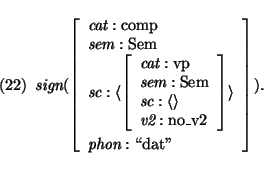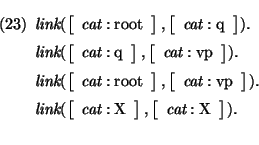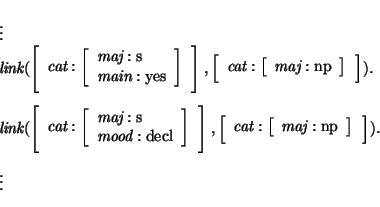



Next: Memo relations
Up: Some Possible Extensions
Previous: Restrictions on heads
The prediction step, as it is defined in BUG, only uses semantic
information. However, it is possible to extend the prediction step to
take into account syntactic information as well. This is
especially useful for grammars that define words that are semantically
empty. For example, assume our Dutch grammar is extended with the
complementizer dat (that) as defined in 22.

In this entry, the semantics of the embedded verb phrase is simply
`taken over' as the semantics of the complementizer, and hence of the
complementizer phrase headed by `dat'. Such lexical entries will be
candidates for each invocation of the prediction step, because they
are completely ignorant as to what semantics they may end up with.
This leads to gross efficiency problems as has been observed in
practice.
Suppose, however, that the prediction step is augmented with syntactic
information. If the goal is to generate a verb phrase, then it is
obvious from the grammar, that it is useless to predict a
complementizer at that point, because the only results of connecting a
complementizer upwards will be a complementizer phrase. Assume that
the predicate
link(Moth,Head) is a pre-compiled table of
the reflexive and transitive closure of possible syntactic links
between mothers and heads, similar to the link predicate in the BUP
parser [55] between mothers and left-most daughters. For the
example grammar of this chapter, the predicate can be defined as
follows, if we restrict the link table, to take into account only the
value of the attribute
cat:

It is possible to change the definition of predict_head and
select_rule into the definitions given in 24.

Note that we change the select_rule clause to take four
arguments now. The fourth argument is the top goal (i.e. the second
argument of the sem_head clauses).
In fact, the prediction step does not necessarily have to be
restricted to semantic and syntactic information, as long as it is
possible to pre-compile the reflexive and transitive closure of the
relation between heads and mothers. The `restrictor' technique
discussed by [82] can be used here. Note though
that the semantic information should not be `restricted'. Syntactic
prediction limits the choice of possible lexical entries. The semantic
prediction has a further task in instantiating the semantics of
the lexical entry to ensure that recursive generation calls also have
their semantics specified. This difference is the reason to
differentiate in the foregoing definition of predict_head
between the semantic prediction and the syntactic prediction.
The syntactic linking technique has a problem in that it may produce
spurious ambiguities. For example, consider the following part of a
hypothetical syntactic linking table:

Assume a goal is specified for category
s, and the current
category, that needs to be connected to that goal, is
np.
In that case both clauses are applicable.
However, these two clauses do not necessarily correspond to two
distinct results. In a Prolog implementation this problem may be
solved by a `double negation' trick; i.e. we would write something
like:
where \+ is the negation-as-failure operator. The linking
predicate then reduces to a check that does not introduce new
information, but only filters the application of rules and lexical
entries that cannot be linked to the goal (for that reason the
predicate should be called immediately after the predicates
ncr and
cr, rather than before.).
Doubly negating the semantic prediction step would, of course,
be damaging, because the main task of the semantic prediction is
to further instantiate (the semantics of) the predicted lexical
entries.
Another possibility, to prevent spurious ambiguities of the syntactic
linking device, would be to compute the generalization of all possible
answers every time the `link' predicate is called. In the previous
example this would simply result in neglecting the
main and
mood attributes. In general such a solution requires quite a
bit of overhead. For different grammars different answers will be
possible to the question what the most efficient solution is.




Next: Memo relations
Up: Some Possible Extensions
Previous: Restrictions on heads
Noord G.J.M. van
1998-09-30



